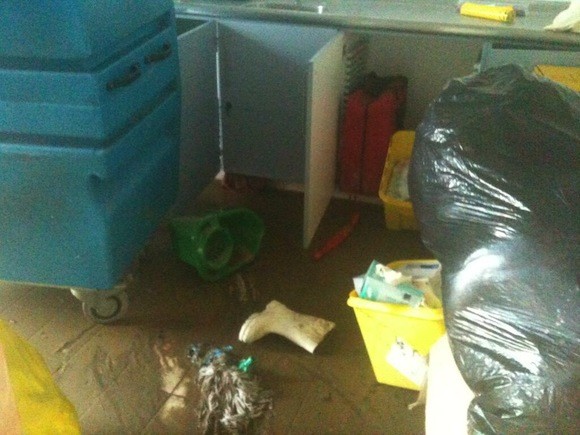SINN FEIN President Gerry Adams visited Letterkenny General Hospital yesterday. In this article he writes about what he saw – and what he thinks now a week on from the flood.
BY GERRY ADAMS, TD: The stream behind Letterkenny Hospital seemed so innocent and innocuous. There was no huge torrent of water rushing through the culvert. It was hardly more than a small stream of water. It looked harmless and it was hard to imagine that last Friday evening it turned into a tidal wave of destruction that swept through the hospital leaving devastation in its wake.
Yesterday morning Padraig McLaughlin TD, and Councillors Gerry McMonagle and Micky McMahon and I visited the hospital to see for ourselves the damage wreaked when the stream burst its banks and contaminated water a metre deep cascaded down through the hospital. Workmen were busy clearing away debris from the stream and from along its course to prevent a recurrence. An independent civil engineering review is currently being carried out to establish what happened and why, and to make recommendations to ensure it doesn’t happen again.
But around 5pm last Friday a deluge of rain saw the culvert break its bank and flood through Letterkenny hospital putting some 40% of the hospital out of action in a frightening and shocking one hour period. Youtube has video of the water rushing down corridors. Staff we spoke to recounted how they desperately moved seriously ill patients out of flooded rooms along debris strewn corridors. Remarkably no one was injured. The hospital staff and emergency services performed heroically and succeeded in getting patients to safety.
Sean Murphy the hospital’s General Manager and Anne Flood the Head of Nursing explained the scale of the emergency but also outlined their efforts to get services back up and running as quickly as possible. As we spoke in a conference room on the ground floor a large lorry arrived outside with a CT scanner. It will be parked in the grounds and put to work. It will be joined by X-ray equipment and an MRI also in lorries.
The extent of the damage is evident in the list of departments closed – the emergency department; the acute medical assessment unit; haematology and oncology; the outpatient department; the radiology department; coronary care; kitchens and support service offices. We spoke to Irish Army soldiers preparing to move medical records. The depth of the water has also meant that some 10,000 files have been damaged and contaminated and will need to be carefully cleaned by specialists.
For patients this is of particular concern as their future treatment will be determined by what those records contain.
The hospital management say that they have received outstanding support from everyone. There has thus far been no quibbling over money and resources. Altnagelvin hospital in Derry and Sligo hospital have picked up some of the work of Letterkenny. Nursing staff and doctors from Letterkenny are travelling to Derry to help Altnegelvin treat Donegal patients. Normally for medical staff to get accreditation to allow them to work in a different jurisdiction would take several months but the respective professional and health providers are co-operating to get this done in days.
The staff, emergency services and Donegal community have rallied to the hospital and are determined to repair all of the damage. It is vital that the government and the HSE step up to the mark and commit themselves to what will be a long term commitment to restore Letterkenny hospital.
Some older parts of the hospital may need to be replaced but even the newer buildings affected have been badly contaminated by the water damage and require significant infrastructure work.
The tour of the hospital revealed to us the extent of the devastation. In one place a line of dirt showed the height the water had reached in the corridors. A lot of the equipment has already been cleaned but the contamination means that specialist cleaning will be required and major infrastructure repairs carried out.
I want to again commend all of the staff and those in the emergency services who have responded to this unique and unparalleled disaster.
Tags:








